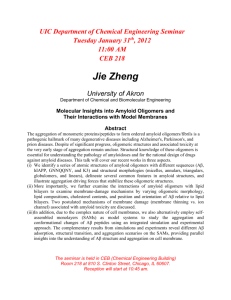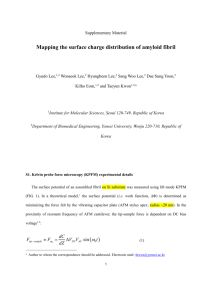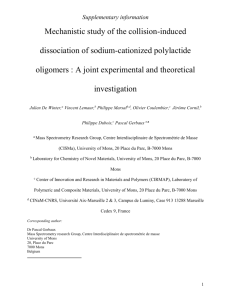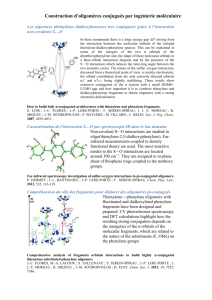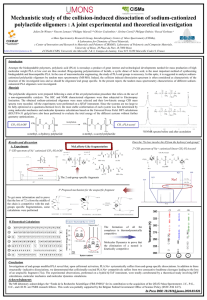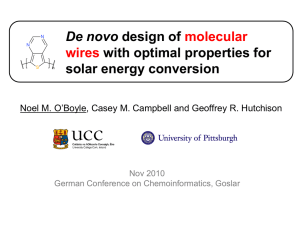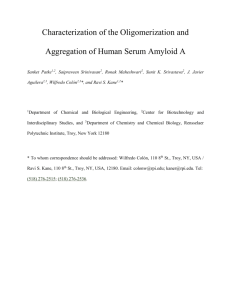Structure-function relationship of oligomers in amyloidosis
advertisement
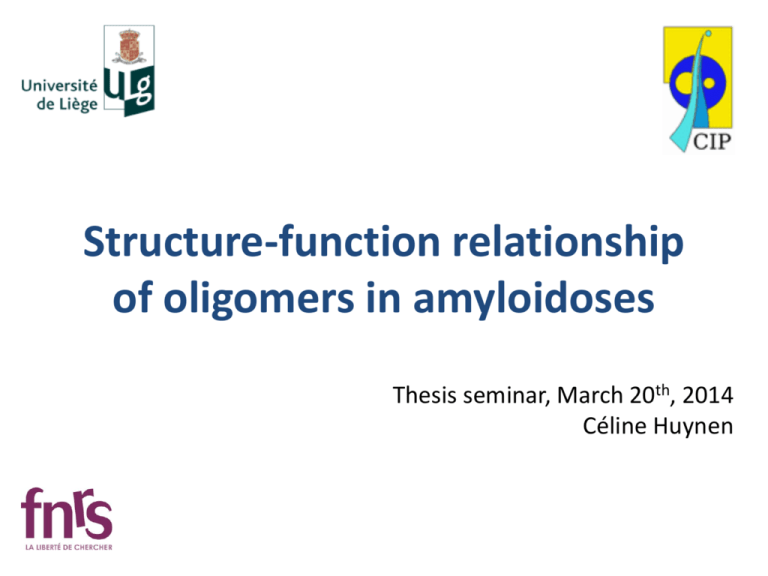
Structure-function relationship of oligomers in amyloidoses Thesis seminar, March 20th, 2014 Céline Huynen AMYLOIDOSES: PROTEIN MISFOLDING DISEASES Chiti and Dobson, 2006, Annu. Rev. Biochem. Parkinson’s disease (α-syn) Alzheimer’s disease (Aβ) Huntington’s disease (htt) NEURODEGENERATIVE DISORDERS Spinocerebellar ataxias (ataxin,…) AMYLOIDOSES: PROTEIN MISFOLDING DISEASES Chiti and Dobson, 2006, Annu. Rev. Biochem. Parkinson’s disease (α-syn) Alzheimer’s disease (Aβ) Huntington’s disease (htt) NEURODEGENERATIVE DISORDERS Spinocerebellar ataxias (ataxin,…) AMYLOIDOSES: PROTEIN MISFOLDING DISEASES AL amyloidosis (Ig light chains) NON-NEUROPATHIC SYSTEMIC AMYLOIDOSES Lysozyme amyloidosis Chiti and Dobson, 2006, Annu. Rev. Biochem. Parkinson’s disease (α-syn) Alzheimer’s disease (Aβ) Huntington’s disease (htt) NEURODEGENERATIVE DISORDERS Spinocerebellar ataxias (ataxin,…) AMYLOIDOSES: PROTEIN MISFOLDING DISEASES AL amyloidosis (Ig light chains) NON-NEUROPATHIC SYSTEMIC AMYLOIDOSES Lysozyme amyloidosis Type II diabetes (IAPP) NON-NEUROPATHIC LOCALIZED AMYLOIDOSES Cataract (γ-Crystallin) Chiti and Dobson, 2006, Annu. Rev. Biochem. Prevalence of Neurodegenerative Diseases (ND) Alzheimer’s and Parkinson’s diseases are respectively the 6th and 14th cause of death in USA in 2010 Cause of death % 2009 to 2010 (%) Heart diseases 24.2 - 2.0 Cancer 23.3 - 0.4 Accidents 4.9 + 1.3 Alzheimer’s disease 3.4 + 3.7 Parkinson’s disease 0.9 + 6.8 Shery et al., 2010, NVSS Prevalence of Neurodegenerative Diseases (ND) Cause of death Heart diseases Cancer Accidents Alzheimer’s disease Parkinson’s disease Rate per 100 000 U.S. std pop. Alzheimer’s and Parkinson’s diseases are respectively the 6th and 14th cause of death in 2010 in USA 1000 100 10 1 0.1 1960 1965 1970 1975 1980 1985 1990 1995 2000 Year More and more deaths due to ND and still no treatment Shery et al., 2010, NVSS 2005 2010 Amyloidoses Soluble functional peptide/protein Ex: Aβ (AD), α-synuclein (PD), huntingtin (HD), IAPP (type II diabetes) Stefani and Dobson, 2003, J Mol Med Higly organized insoluble fibrillar aggregates extra- or intra-cellular deposits Amyloid fibrils Amyloid fibrils Soluble functional peptide/protein Ex: Aβ (AD), α-synuclein (PD), huntingtin (HD), IAPP (type II diabetes) No sequence identity or structural homology Higly organized insoluble fibrillar aggregates extra- or intra-cellular deposits Amyloid fibrils Common motif Fibrillar appearance (TEM + AFM) Stefani and Dobson, 2003, J Mol Med Amyloid fibrils Soluble functional peptide/protein Ex: Aβ (AD), α-synuclein (PD), huntingtin (HD), IAPP (type II diabetes) Higly organized insoluble fibrillar aggregates extra- or intra-cellular deposits Amyloid fibrils Common motif No sequence identity or structural homology Fibrillar appearance (TEM + AFM) Fibrils (up to 30 nm wide): 2-6 protofilaments (2-5 nm diameter) twistest or laterally associated 4 twisted protofilaments Stefani and Dobson, 2003, J Mol Med Stefani and Dobson, 2003, J Mol Med Amyloid fibrils Soluble functional peptide/protein Ex: Aβ (AD), α-synuclein (PD), huntingtin (HD), IAPP (type II diabete) No sequence identity or structural homology Higly organized insoluble fibrillar aggregates extra- or intra-cellular deposits Amyloid fibrils Common motif Fibrillar appearance (TEM + AFM) 2-6 protofilaments Cross-β structure Thioflavin T and Congo red Dumoulin and Dobson, 2004, Biochimie Stefani and Dobson, 2003, J Mol Med Amyloid fibril formation = toxic gain of function Soluble functional peptide/protein Amyloid fibrils No sequence identity or structural homology Common motif Common mechanism of formation Conserved mechanism of pathogenesis for phenotypically diverse diseases TOXIC GAIN OF FUNCTION Lotz and Legleiter, 2013, J Mol Med; Winklhofer et al., 2008, EMBO; Bucciantini et al., 2002, Nature, Gillam and MacPhee, 2013, J. Phys. Kinetics of amyloid fibril formation Generic property of polypetide chains, Astbury and Dickinson, 1935 Aggregation What are the toxic species? F Maturation MF Nucleation M Coralie Pain MM D N Time Plan of the presentation 1) Fibrils versus oligomers: Who is toxic? 2) How can we study oligomers? in vivo and in vitro techniques 3) What are the different oligomeric species and their structure? 4) Why are oligomers toxic? 5) Strategies to interfere with the toxicity associated with oligomers 1) Fibrils versus oligomers: Who is toxic? Mechanism of amyloid fibril formation Intrinsically disordered proteins Native proteins in dynamic equilibrium with different conformations (e.g., partially unfolded or misfolded species more aggregation-prone) Mutations, misprocessing, aberrant interactions, changes in environmental conditions, chemical modifications, enhanced protein synthesis, reduction of protein clearance can increase the population of aggregation –prone conformations Lotz and Legleiter, 2013, J Mol Med, Stefani and Dobson, 2003, J Mol Med, Gillam and MacPhee, 2013, J. Phys. Mechanism of amyloid fibril formation Various intermediate aggregated states, on- or off- pathways, depending on proteins and conditions Amyloid fibrils and plaques Lotz and Legleiter, 2013, J Mol Med Amyloid fibrils = toxic species … or … ? Amyloid fibrils and plaques Irreversible sequestration of different proteins loss of their function Jellinger, 2009, Neuronal transm Reservoirs of soluble toxic species Winklhofer et al., 2008, EMBO Amyloid fibrils = toxic species … or … ? Amyloid fibrils and plaques Irreversible sequestration of different proteins loss of their function Jellinger, 2009, Neuronal transm Reservoirs of soluble toxic species Winklhofer et al., 2008, EMBO Systemic or localized amyloidoses: Accumulation of kg of fibrils in organs and tissues: steric rigidity, inelasticity impairment and dysfunction of tissue architecture Chiti and Dobson, Annu Rev Biochem, 2006; Pepys, 2006, Annu Rev Med; Pepys, 2001, Phil Trans R Soc Soc Lond B Amyloid fibrils = toxic species … or … ? Amyloid fibrils and plaques Irreversible sequestration of different proteins loss of their function Jellinger, 2009, Neuronal transm Reservoirs of soluble toxic species Winklhofer et al., 2008, EMBO Systemic or localized amyloidoses: Accumulation of kg of fibrils in organs and tissues: steric rigidity, inelasticity impairment and dysfunction of tissue architecture Chiti and Dobson, Annu Rev Biochem, 2006; Pepys, 2006, Annu Rev Med; Pepys, 2001, Phil Trans R Soc Soc Lond B Neurodegenerative amyloidoses: Aβ deposits in cerebral blood vessel walls: hemorrhages and stroke Amyloid fibrils of Aβ = toxic to cultured neuronal cells by inducing membrane depolarization Pepys, 2006, Annu Rev Med; Fändrich, 2012, J Mol Med; chiti and dobson, Annu. Rev. Biochem, 2006 Amyloid fibrils = toxic species … or … protective? Amyloid fibrils and plaques The number of fibril plaques and inclusions do not correlate well with symptoms and severity of the disease Fibrils = inert and inactive insoluble end-products sequestering soluble toxic species? Jellinger, 2009, Neuronal transm; Fändrich, 2012, J Mol Med Toxic species are soluble oligomeric intermediates Soluble intermediate aggregates correlate with neurotoxicity (e.g., cognitive impairment in AD) Lue et al., 1999, Am J Pathol Toxic species are soluble oligomeric intermediates Soluble intermediate aggregates correlate with neurotoxicity (e.g., cognitive impairment in AD) Lue et al., 1999, Am J Pathol Immunization with anti-Aβ antibody reduce memory loss in AD mouses but not amyloid plaques Dodart et al., 2002, Nat Neurosci Toxic species are soluble oligomeric intermediates Soluble intermediate aggregates correlate with neurotoxicity (e.g., cognitive impairment in AD) Lue et al., 1999, Am J Pathol Immunization with anti-Aβ antibody reduce memory loss in AD mouses but not amyloid plaques Dodart et al., 2002, Nat Neurosci Transgenic mice with non-fibrillar α-synuclein depositions: motor deficiencies and losses of dopaminergic neurones Masliah et al., 2000, Science Toxic species are soluble oligomeric intermediates Soluble intermediate aggregates correlate with neurotoxicity (e.g., cognitive impairment in AD) Lue et al., 1999, Am J Pathol Immunization with anti-Aβ antibody reduce memory loss in AD mouses but not amyloid plaques Dodart et al., 2002, Nat Neurosci Transgenic mice with nonfibrillar α-synuclein depositions: motor deficiencies and losses of dopaminergic neurones Masliah et al., 2000, Science Prefibrillar species of non disease-associated proteins (SH3 domain from PI3 and N-ter domain of HypF) are highly cytotoxic in vitro Bucciantini et al., 2002, Nature 2) How can we study oligomers? in vivo and in vitro techniques Different techniques to study oligomers Dynamic light scattering (DLS) + size exclusion chromatography (SEC): Size and proportion of the different populations of species inside a protein sample (e.g. monomers – oligomers – fibrils) DLS Large oligomers Small oligomers Monomers Redecke et al., 2007, jsb Different techniques to study oligomers Dynamic light scattering (DLS) + size exclusion chromatography (SEC): Size and proportion of the different populations of species inside a protein sample (e.g. monomers – oligomers – fibrils) Native Large SEC monomers particles Oligomeric species Monomers Ruzafa et al., 2012, PLOS ONE Different techniques to study oligomers Dynamic light scattering (DLS) + size exclusion chromatography (SEC) Atomic force microscopy (AFM) and transmission electron microscopy (TEM): size and morphology of the species AFM TEM Spherical oligomers Bartolini et al., 2011, Anal Biochem Celej et al., 2012, Biochem J Different techniques to study oligomers Dynamic light scattering (DLS) + size exclusion chromatography (SEC) Atomic force microscopy (AFM) and transmission electron microscopy (TEM) Circular dichroism (CD) and Infrared spectroscopy (FTIR): β-sheet structures CD Oligomers with β-sheet conformation: min at 217 nm Monomers Redecke et al., 2007, jsb Different techniques to study oligomers Dynamic light scattering (DLS) + size exclusion chromatography (SEC) Atomic force microscopy (AFM) and transmission electron microscopy (TEM) Circular dichroism (CD) and Infrared spectroscopy (FTIR): β-sheet structures ATR-FTIR: Amide I absorption band Oligomers 1695 cm-1 1625 cm-1 Antiparallel β-sheet Fibrils 1628 cm-1 Parallel β-sheet Celej et al., 2010, Biochem. J. Different techniques to study oligomers Dynamic light scattering (DLS) + size exclusion chromatography (SEC) Atomic force microscopy (AFM) and transmission electron microscopy (TEM) Circular dichroism (CD) and Infrared spectroscopy (FTIR) ANS fluorescence intensity, 470 nm (a.u.) ANS binding: exposure of hydrophobic patches HypF-N oligomers (A conditions) HypF-N oligomers (B conditions) [ANS] (µM) Campioni et al., 2010, nature chemical biology Different techniques to study oligomers Dynamic light scattering (DLS) + size exclusion chromatography (SEC) Atomic force microscopy (AFM) and transmission electron microscopy (TEM) Circular dichroism (CD) and Infrared spectroscopy (FTIR) ANS binding Thioflavin T (ThT) + congo Red binding: amyloid character Frändrich, 2012, J. Mol. Med. Different techniques to study oligomers Dynamic light scattering (DLS) + size exclusion chromatography (SEC) Atomic force microscopy (AFM) and transmission electron microscopy (TEM) Circular dichroism (CD) and Infrared spectroscopy (FTIR) ANS binding Thioflavin T (ThT) + congo Red binding MTT test: cytotoxicity of cultured cells Oligomers Bucciantini et al., 2002, Nature Different techniques to study oligomers In vivo techniques: injection of fluorescently labeled oligomer species in rat brains Activation of microglia (inflamatory response) Viability of ChAT neurons In vivo techniques + Ab A11 Baglioni et al., 2006, J. neurosci. An antibody specific to oligomers to perform in vivo and in vitro experiments Rabbit immunization with Aβ synthetic oligomers Polyclonal serum immunoreactivity Monomers and low-MW species Ab Spherical oligomers (TEM) Elongated protofibrils (TEM) Oligomeric species Fibrils Ab Kayed et al., 2003, Science An antibody specific to oligomers to perform in vivo and in vitro experiments Specific to soluble oligomer intermediates of many amyloid proteins and peptides Common epitope ο Soluble Oligomers ▲ Monomers and Low-MW species ■ Fibrils Kayed et al., 2003, Science An antibody specific to oligomers to perform in vivo and in vitro experiments AD brains Control brains: Not demented Specific to soluble oligomer intermediates of many amyloid proteins and peptides Useful to detect oligomers in human AD brains Relevance of oligomers formed in vitro AD brains Green: Clusters of immunoreactive deposits: spherical and curvilinear structure = oligomers Red: fibrils stained by thioflavin S Kayed et al., 2003, Science 3) What are the different oligomeric species and their stucture Amyloid intermediates A wide range of proteins associated with ND form soluble amyloid intermediates (oligomers): Aβ (AD) Tau (AD) α-synuclein (PD) PrP (spongiform encephalopathies) polyQ proteins (HD and spinocerebellar ataxias) … And also proteins associated with non-neuropathic amyloidoses and not associated with diseases Metastable/transient species difficult to study Many intermediate species: high diversity in shape, in size, and in structure Many different conditions to study and form oligomers Complexicity Gadad, 2011, Journal of AD; Kayed and Glabe, 2006, Methods in enzymology; Jellinger, 2009, J Neural Transm Structure and diversity of Aβ amyloid oligomers From dimers to high molecular mass soluble species (< 10 to > 100 kDa) SDS stable low-n oligomers (di- trimers to dodecamers) Building blocks for the formation of larger soluble oligomers and insoluble fibrils Toxic Gadad et al., 2011, Journal of AD; Walsh and Selkoe, 2007, J Neurochem Bartolini et al., 2011, Anal Biochem Structure and diversity of Aβ amyloid oligomers From dimers to high molecular mass soluble species (< 10 to > 100 kDa) Spherical oligomers (10 – 25 nm diameter) ADDL (Aβ-derived diffusible ligands) = globular oligomers (4-5 nm diameter) Highly neurotoxic Walsh and Selkoe, 2007, J Neurochem; Bartolini et al., 2011, Anal Biochem; Kayed and Reeves, 2013, Journal of AD; Gadad et al., 2011, Journal of AD Bartolini et al., 2011, Anal Biochem Spherical oligomers AFM Kayed and Reeves, 2013, Journal of AD Bartolini et al., 2011, Anal Biochem Structure and diversity of Aβ amyloid oligomers From dimers to high molecular mass soluble species (< 10 to > 100 kDa) Spherical oligomers ADDL Bartolini et al., 2011, Anal Biochem Annular oligomers (150 – 250 kDa, 8 – 12 outer diameter, 2.0 – 2.5 inner diameter): doughnut-like structure Cytotoxicity: Formation of non-specific pores such as cytolytic β-barrel pore-forming toxins Gadad et al., 2011, Journal of AD Kayed and Reeves, 2013, Journal of AD Structure and diversity of Aβ amyloid oligomers From dimers to high molecular mass soluble species (< 10 to > 100 kDa) Bartolini et al., 2011, Anal Biochem Bartolini et al., 2011, Anal Biochem Protofibrils (1 – 3 nm height, 5 – 10 nm width, > 110 nm length): curvilinear structure that can dissociate into low molecular weight oligomers or form fibrils Toxic Walsh and Selkoe, 2007, J Neurochem; Kayed and Reeves, 2013, Journal of AD; Bartolini et al., 2011, Anal Biochem Structure and diversity of amyloid oligomers Spherical oligomers (10-60 nm diameter, α-synuclein Di/trimers β-sheet structure, cytotoxic) Ring circularized oligomers (annular, circular or elliptical, cytotoxic, prevent fibril formation?) Protofibrils (granular, cytotoxic, precursor of fibrils) Spherical oligomers Circular annular oligomers 35-55 nm diameter Elliptical annular oligomers 35-55 nm width, 65-130 nm length Conway et al., 2000, PNAS Celej et al., 2012, Biochem J Conway et al., 2000, PNAS Hashimoto et al., 1998, Brain Research; Daturpalli et al., 2013, J Mol Biol; Gadad et al., 2011, Journal of AD; Conway et al., 2000, PNAS; Celej et al., 2012, Biochem J Structure and diversity of amyloid oligomers α-synuclein Di/trimers Spherical oligomers Ring circularized oligomers Protofibrils Soluble oligomers (> 60 kDa, toxic, βPolyQ peptides strands, rapidely incorporated into inclusion bodies) Takahashi et al., 2008, Human Molecular Genetics Structure and diversity of amyloid oligomers α-synuclein Di/trimers PolyQ peptides PolyQ proteins (Sperm whale Myo, htt, Atx3:) Spherical oligomers Ring circularized oligomers Protofibrils Soluble oligomers Non-fibrillar aggregates, amorphous aggregates (3, 80-90 mers, β-sheets not orderly aligned) Spheroids (1, Small and globular, 5-65 nm diameter, beta sheet structure) Annular oligomers (2, 100 nm diameter) Protofibrils (4, short and curvilinear, up to 2 µm length, not resistant to SDS denaturation) Tanaka et al., 2003, jbc; Poirier et al., 2002, J Biol Chem , Hands and wyttenbach, 2010, Acta Neuropathol Structure and diversity of amyloid oligomers α-synuclein Di/trimers Spherical oligomers Ring circularized oligomers Protofibrils PolyQ peptides Soluble oligomers PolyQ proteins Non-fibrillar quasi aggregate, amorphous aggregates; Spheroids; Annular oligomers Protofibrils Small soluble and globular oligomers (β-sheet rich, 13.1 ± 0.4 nm hydrodynamic Elongated-shape oligomers (β-sheet rich, 38.7 radius, 8.2 ± 2.4 nm radius 14 – 28 mers, 300 – 600 kDa , cytotoxic in vitro and in infected hamster brain) ± 9.3 nm hydrodynamic radius, 31.1 ± 6 nm radius, ~ 100 mers) Prion protein Redecke et al., 2007, jsb; Gadad et al., 2011, Journal of AD; Silveira et al., 2005, Nature Structure and diversity of amyloid oligomers α-synuclein Di/trimers Spherical oligomers Ring circularized oligomers Protofibrils PolyQ peptides Soluble oligomers PolyQ proteins Non-fibrillar quasi aggregate, amorphous aggregates; Spheroids; Annular oligomers Protofibrils Prion protein Small soluble and globular oligomers Annular Spheroid Elongated-shape oligomers Protofibrils Transthyretin Native tetramers Monodimers Annular oligomeric intermediates (16 ± 2 nm diameter, octametric symmetry, ~15 nm Rh unstable) Spheroid oligomers (spherical, more compact , 8.3 nm Rh) Protofibrils (3.6 nm thickness, up to 60-300 nm length formation and growth from spheroid oligomers) Pires et al., 2012, PLOS ONE Structure and diversity of amyloid oligomers α-synuclein Di/trimers Spherical oligomers Ring circularized oligomers Protofibrils PolyQ peptides Soluble oligomers PolyQ proteins Non-fibrillar quasi aggregate, amorphous aggregates; Spheroids; Annular oligomers Protofibrils Prion protein Small soluble and globular oligomers Elongated-shape oligomers Annular oligomeric intermediates Spheroid oligomers Protofibrils Transthyretin SH3-N47A (PI3 kinase) Native tetramers Monodimers Low-populated, heterogeneous, unstable, βsheet structure, exposition of hydrophobic patches Ruzafa et al., 2012, PLOS ONE Structure and diversity of amyloid oligomers α-synuclein Di/trimers Spherical oligomers Ring circularized oligomers Protofibrils PolyQ peptides Soluble oligomers PolyQ proteins Non-fibrillar quasi aggregate, amorphous aggregates; Spheroids; Annular oligomers Protofibrils Prion protein Small soluble and globular oligomers Elongated-shape oligomers Annular oligomeric intermediates Spheroid oligomers Protofibrils Transthyretin SH3-N47A Native tetramers Monodimers β-sheet, hydrophobic patches exposed 2 Spherical oligomers (intermolecular βHypF-N (E. coli) Protofibils sheets, hydrophobic regions exposed vs in the core, cross vs bind cell mb, toxic vs not) Campioni et al., 2010, N Chemical Bio Common oligomeric structures Small oligomers: dimers – dodecamers Spherical oligomers (10-60 nm diameter) Annular oligomers Protofibrils Robertson and Bottomley, 2012, Landes Bioscience and Springer; Kayed et al., 2003, Science; Chiti and Dobson, 2006, Annu. Rev. Biochem.; Glabe, 2006, Neurobiology of aging, Hashimoto et al., 1998, Brain Research; Daturpalli et al., 2013, J Mol Biol; Gadad et al., 2011, Journal of AD; Conway et al., 2000, PNAS; Celej et al., 2012, Biochem Common oligomeric structures Small oligomers: dimers – dodecamers Spherical oligomers (10-60 nm diameter) Annular oligomers Protofibrils Amyloid character Antiparallel β-sheet structure Exposition of hydrophobic regions Different common epitopes (A11-OC-…) Robertson and Bottomley, 2012, Landes Bioscience and Springer; Kayed et al., 2003, Science; Chiti and Dobson, 2006, Annu. Rev. Biochem.; Glabe, 2006, Neurobiology of aging, Hashimoto et al., 1998, Brain Research; Daturpalli et al., 2013, J Mol Biol; Gadad et al., 2011, Journal of AD; Conway et al., 2000, PNAS; Celej et al., 2012, Biochem Common oligomeric structures Small oligomers: dimers – dodecamers Spherical oligomers (10-60 nm diameter) Annular oligomers Unique common structural feature of the polypeptide backboneProtofibrils in amyloid soluble oligomers, different from fibrils and monomers Amyloid character Antiparallel β-sheet structure Exposition of hydrophobic regions Different common epitopes (A11-OC-…) Robertson and Bottomley, 2012, Landes Bioscience and Springer; Kayed et al., 2003, Science; Chiti and Dobson, 2006, Annu. Rev. Biochem.; Glabe, 2006, Neurobiology of aging, Hashimoto et al., 1998, Brain Research; Daturpalli et al., 2013, J Mol Biol; Gadad et al., 2011, Journal of AD; Conway et al., 2000, PNAS; Celej et al., 2012, Biochem Similar structural organization of oligomers Similar mechanism of toxicity Robertson and Bottomley, 2012, Landes Bioscience and Springer; Kayed et al., 2003, Science 4) Why are oligomers toxic? Oligomer-associated cytotoxicity Structural features of oligomers cytotoxicity Aberrant interaction and sequestration of other proteins and cellular components (via exposition of hydrophobic sites or polyQ domains) impair their function Lotz and Legleiter, 2013, J Mol Med; Chiti and Dobson, 2006, Annu. Rev. Biochem.; Glabe, 2006, Neurobiology of aging; Frändrich 2012, JMB; Jellinger, 2009, J Neural Transm Oligomer-associated cytotoxicity Structural features of oligomers cytotoxicity Aberrant interaction and sequestration of other proteins and cellular components Interference with the central protein quality control/clearance mechanism (overwhelmed + sequestration of their components) Lotz and Legleiter, 2013, J Mol Med; Chiti and Dobson, 2006, Annu. Rev. Biochem.; Glabe, 2006, Neurobiology of aging; Frändrich 2012, JMB; Jellinger, 2009, J Neural Transm Oligomer-associated cytotoxicity Structural features of oligomers cytotoxicity Aberrant interaction and sequestration of other proteins and cellular components Interference with the central protein quality control/clearance mechanism Interaction with cell membranes: disruption of the membrane integrity - channel hypothesis – ion permeability Lotz and Legleiter, 2013, J Mol Med; Chiti and Dobson, 2006, Annu. Rev. Biochem.; Glabe, 2006, Neurobiology of aging; Frändrich 2012, JMB; Jellinger, 2009, J Neural Transm Oligomer-associated cytotoxicity Structural features of oligomers cytotoxicity Aberrant interaction and sequestration of other proteins and cellular components Interference with the central protein quality control/clearance mechanism Interaction with cell membranes Oxidative stress and ROS production (reactive oxygen species) Lotz and Legleiter, 2013, J Mol Med; Chiti and Dobson, 2006, Annu. Rev. Biochem.; Glabe, 2006, Neurobiology of aging; Frändrich 2012, JMB; Jellinger, 2009, J Neural Transm Oligomer-associated cytotoxicity Structural features of oligomers cytotoxicity Aberrant interaction and sequestration of other proteins and cellular components Interference with the central protein quality control/clearance mechanism Interaction with cell membranes Oxidative stress and ROS production Mitochondrial dysfunction, Fragmentation of the Golgi apparatus Lotz and Legleiter, 2013, J Mol Med; Chiti and Dobson, 2006, Annu. Rev. Biochem.; Glabe, 2006, Neurobiology of aging; Frändrich 2012, JMB; Jellinger, 2009, J Neural Transm Oligomer-associated cytotoxicity Structural features of oligomers cytotoxicity Aberrant interaction and sequestration of other proteins and cellular components Interference with the central protein quality control/clearance mechanism Interaction with cell membranes Oxidative stress and ROS production Mitochondrial dysfunction, Fragmentation of the Golgi apparatus Interference with the axonal transport Lotz and Legleiter, 2013, J Mol Med; Chiti and Dobson, 2006, Annu. Rev. Biochem.; Glabe, 2006, Neurobiology of aging; Frändrich 2012, JMB; Jellinger, 2009, J Neural Transm Oligomer-associated cytotoxicity Structural features of oligomers cytotoxicity Aberrant interaction and sequestration of other proteins and cellular components Interference with the central protein quality control/clearance mechanism Interaction with cell membranes Interrelated in a complex vicious circle Oxidative stress and ROS production Mitochondrial dysfunction, Fragmentation of the Golgi apparatus Interference with the axonal transport Lotz and Legleiter, 2013, J Mol Med; Chiti and Dobson, 2006, Annu. Rev. Biochem.; Glabe, 2006, Neurobiology of aging; Frändrich 2012, JMB; Jellinger, 2009, J Neural Transm Oligomer-associated cytotoxicity Interaction with cell membranes: disruption of the membrane integrity - channel hypothesis – ion permeability (exposition of hydrophobic regions, antiparallel β-sheet β-barrel, similar to bacterial porins) Ca2+ Extracellular Cytoplasmic membrane Intracellular Oligomers Oxidative stress + ROS production Influx [Ca2+] increase Leakage Cytochrom C release Ca2+ Apoptosis Intracellular membrane (e.g. mitochondria, ER) Glabe, 2006, Neurobiology of aging; Guo et al., 2009, Handbook of Neurochemistry and Molecular Neurobiology; Frändrich 2012, JMB ; Campioni et al., 2010, N Chemical Bio; Hands and Wyttenbach, 2010, Acta Neuropathol; Cerf et al., 2009, Biochem. J. Example: Neurotoxicity of Aβ oligomers 1) Interaction with cell surface Kayed and Reeves, 2013, Journal of AD Example: Neurotoxicity of Aβ oligomers 1) Interaction with cell surface 2) Aberrant Interaction with membrane receptors Kayed and Reeves, 2013, Journal of AD Example: Neurotoxicity of Aβ oligomers 1) Interaction with cell surface 2) Aberrant Interaction with membrane receptors 3) Intracellular actions Neuronal receptors Impairs their endocytic trafficking: Synaptic dysfunction Kayed and Reeves, 2013, Journal of AD 4) Strategies to interfere with the toxicity associated with oligomers Therapeutic strategies targeting oligomerization Stabilization of the native conformer (e.g. chaperones induction: Hsp70 vs α-syn) Oligomerization Gadad et al., 2011, Journal of AD; Lotz and Legleiter, 2013, J Mol Med Therapeutic strategies targeting oligomerization Stabilization of the native conformer β-sheet breaker or blocker: peptide-based inhibitor, small synthetic peptides or molecules Oligomerization E.g. Methylene blue vs Aβ: phase II, promising Gadad et al., 2011, Journal of AD; Lotz and Legleiter, 2013, J Mol Med Therapeutic strategies targeting oligomerization Stabilization of the native conformer β-sheet breaker or blocker Decrease the amount of monomers: RNAi or antisens oligonucleotide (under investigation) Gadad et al., 2011, Journal of AD; Lotz and Legleiter, 2013, J Mol Med Therapeutic strategies targeting oligomerization Stabilization of the native conformer β-sheet breaker or blocker Decrease the amount of monomers Post-translational modifications (e.g. acetylation – phosphorylation – sumoylation – ubiquitination – palmitoyaltion - …) Interfere with aggregation propensity and proteolysis Gadad et al., 2011, Journal of AD; Lotz and Legleiter, 2013, J Mol Med Therapeutic strategies targeting oligomerization Stabilization of the native conformer β-sheet breaker or blocker Decrease the amount of monomers Post-translational modifications Active and passive immunization Oligomerization Ab vs Aβ decreases aggregation and pathology (cross BBB): clinical trials (e.g. bapineuzumab, solanezumab, gantenerumab) Injection of synthetic Aβ peptide in mice: reduced pathology Gadad et al., 2011, Journal of AD; Lotz and Legleiter, 2013, J Mol Med A chaperone to block oligomer’s toxicity Hsp90 vs A53T α-synuclein SEC: Superdex 200 10/300 column SDS-PAGE O P1 P2 P1 P2 P1 P2 Hsp90 Void volume Hsp90 Hsp90 + oligomers oligomers Hsp90 Oligomers Co-elution of Hsp90 + oligomers Hsp90 forms a stable complex with A53T α-synuclein Daturpalli et al., 2013, J Mol Med A chaperone to block oligomer’s toxicity Hsp90 vs A53T α-synuclein A53T:Hsp90 at 10:1 ratio A53T:Hsp90 at 2:1 ratio A53T Hsp90 inhibits the aggregation of A53T α-synuclein Daturpalli et al., 2013, J Mol Med A chaperone to block oligomer’s toxicity Hsp90 vs A53T α-synuclein Cell viability A53T A53T + Hsp90 Hsp90 decreases cell death induced by A53T α-synuclein Daturpalli et al., 2013, J Mol Med A chaperone to block oligomer’s toxicity Hsp90 vs A53T α-synuclein Hsp90 forms non-specific hydrophobic interactions with A53T oligomers and preferentially recognizes more structured oligomeric states This interaction further prevents toxicity by shielding a potential toxic surface, inducing a conformational rearrangement, or stabilizing a specific structure Daturpalli et al., 2013, J Mol Med An antibody recognizing many amyloid oligomers Kayed and Glabe, 2006, Method in Enzymology, Vol. 413: Identification of a common anti-oligomer antibody Inhibit oligomer cytotoxicty Kayed et al., 2003, Science An antibody recognizing many amyloid oligomers Kayed and Glabe, 2006, Method in Enzymology, Vol. 413: Identification of a common anti-oligomer antibody Detection, localization and quantification of oligomers in cell and brains diagnostic Good predictor for disease onset and progression Block oligomers toxicity in vitro therapeutic tool via active or passive immunization Identify the exact role of oligomers Screening of compounds that prevent/reverse oligomer formation Identify new amyloidoses? Conclusions Amyloidoses: Neurodegenerative and Non-neuropathic diseases Many different peptides/proteins One amyloid fold (amyloid fibrils and amyloid plaques) Conclusions Amyloidoses: Neurodegenerative and Non-neuropathic diseases Many different peptides/proteins One amyloid fold Via oligomer formation = toxic species? Spherical oligomers Annular oligomers Protofibrils Non fibrillar Amyloid-like structure Antiparallel β-sheet structure Exposition of hydrophobic patches Unique common structural motif (common epitope) Conclusions Amyloidoses: Neurodegenerative and Non-neuropathic diseases Many different peptides/proteins One amyloid fold Via oligomer formation = toxic species? Similar mechanism of toxicity linked to their particular structural features Aberrant interaction with cellular components Interference with the protein quality control Membrane disruption Oxidative stress, ROS production, mitochondrial dysfunction Interference with the axonal transport Apoptosis and neurodegeneration Conclusions Amyloidoses: Neurodegenerative and Non-neuropathic diseases Many different peptides/proteins One amyloid fold Via oligomer formation = toxic species? Valuable targets to interfere with the toxicity associated with these pathologies 1) Oligomerization inhibition via: Stabilization of the native state, reducing the amount of protein production, β-sheet breaker/blocker, post-translational modifications,… 2) Direct interaction to oligomers via: Passive/active immunization, chaperone induction,… Thank you for your attention Calcium and Apoptosis Guo et al., 2009, Handbook of Neurochemistry and Molecular Neurobiology
